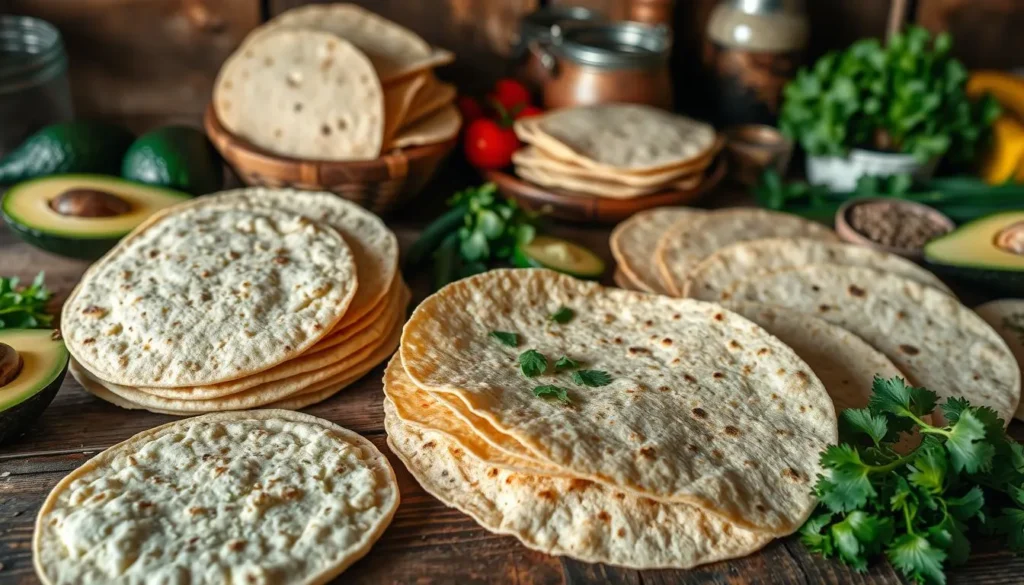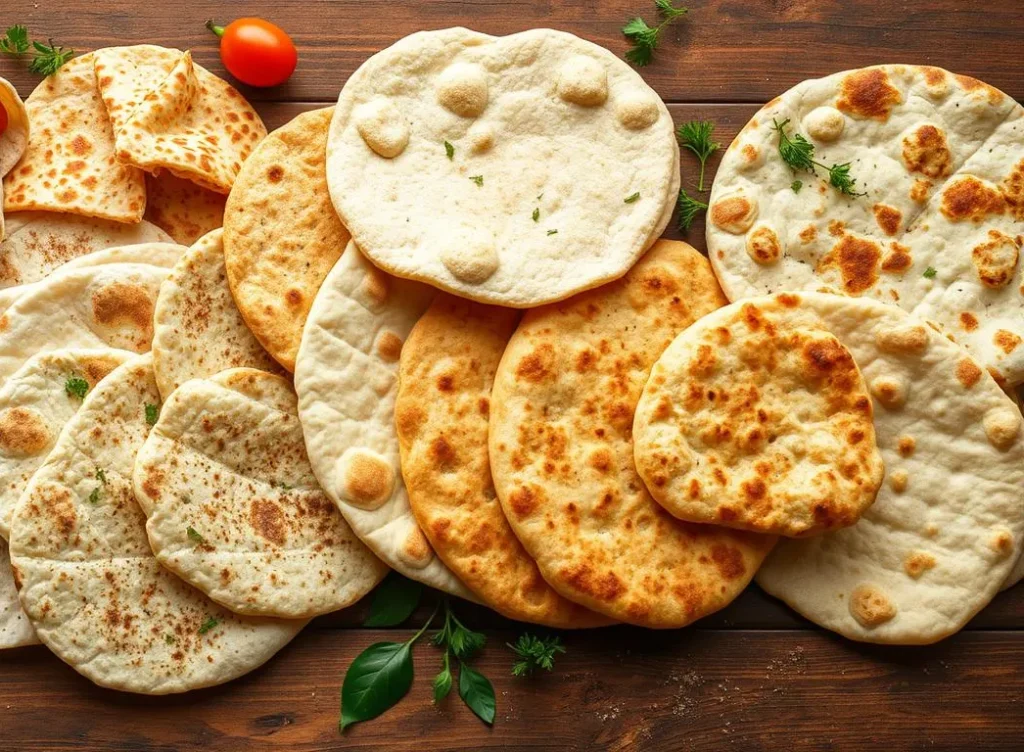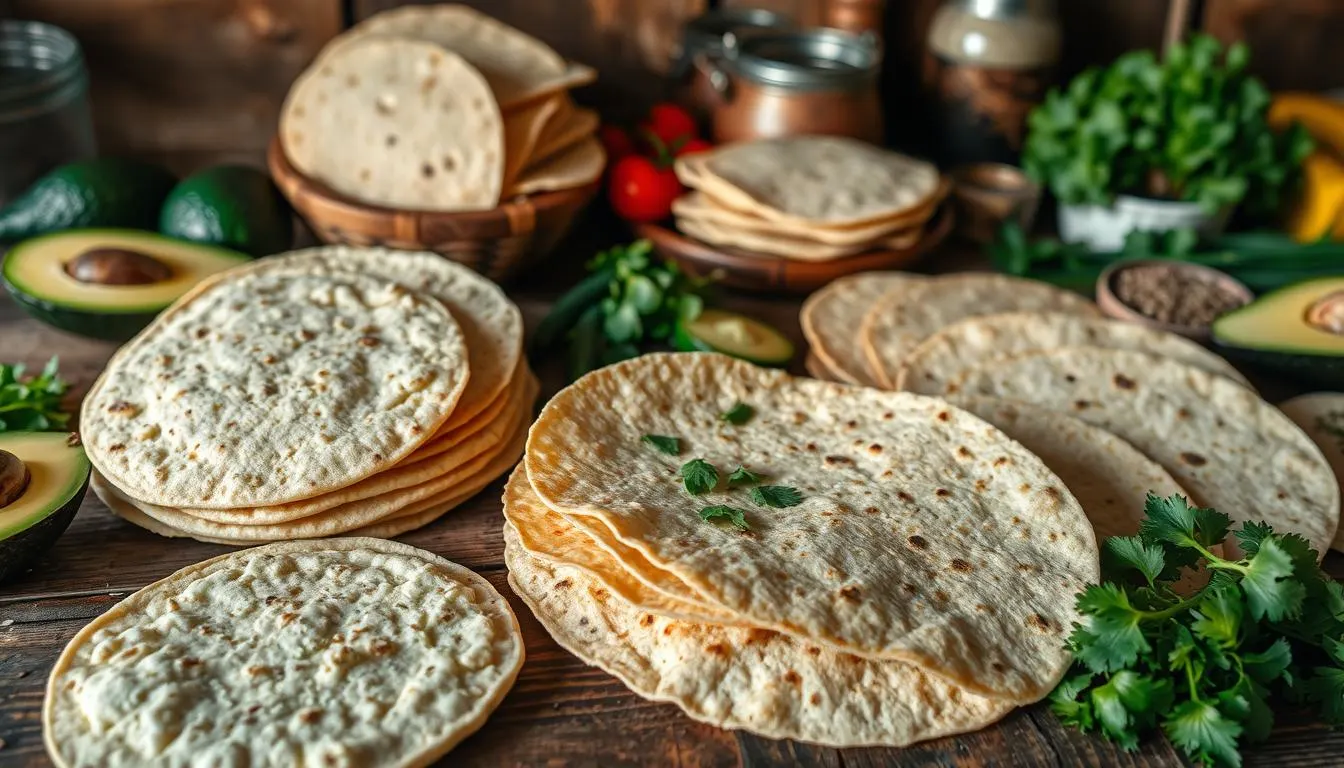I love exploring the world of flatbreads. From France’s thin crepes to India’s thick naan, each culture has its own special flatbread. The wrap and tortilla stand out to me. They are simple yet full of possibilities, used in many dishes around the world.

Ever thought about what makes a wrap different from a tortilla? In this article, we’ll look into their origins, what makes them special, and how they’re used in cooking. This journey will show you the amazing variety of flavors and fillings these flatbreads can hold. It’s perfect for anyone who loves food or just great sandwiches.
Key Takeaways:
- Wraps and tortillas are distinct flatbread varieties with unique origins and characteristics.
- Tortillas are a staple in Mexican cuisine, while wraps have gained global popularity in various culinary traditions.
- Ingredients, preparation methods, and cultural influences shape the distinct flavors and textures of these flatbreads.
- Understanding the differences between wraps and tortillas can enhance your culinary experiences and inspire new flavor combinations.
- Exploring the versatility and evolution of these flatbreads can deepen your appreciation for the rich diversity of global cuisine.
Understanding Wraps and Tortillas: Basic Definitions
Wraps and tortillas are two main types of flatbreads. They are both great for making meals easy to eat on the go. Knowing what makes each special can help you pick the right one for your dishes.
Essential Components of Modern Wraps
Wraps are made from a mix of wrap ingredients. They are thinner and softer than tortillas. This makes them easy to roll up and fun to eat.
Some common wrap ingredients include:
- Flour or whole grains
- Herbs and spices
- Oils or fats for pliability
- Water or other liquids to bind the dough
Traditional Tortilla Characteristics
Tortilla ingredients come from Latin American traditions. Tortillas can be made from corn or flour. Each has its own taste and feel.
The making of tortillas involves:
- Nixtamalization of corn (a process that enhances nutritional value)
- Careful kneading and shaping of the dough
- Cooking on a hot griddle or comal (a traditional flat pan)
This makes a sturdy, slightly thicker flatbread. It’s perfect for tacos, burritos, quesadillas, and enchiladas.

“Wraps and tortillas may share some similarities, but understanding their distinct characteristics can open up a world of culinary possibilities.”
The Cultural Origins and Evolution of Tortillas
Tortillas have a long history in Mexican cuisine, dating back to ancient Mesoamerica. They have changed over time, becoming a key part of Mexican and Latin American food.
The first tortillas were made from ground corn, cooked on hot stones or clay griddles. These flatbreads were not just food. They were also important in religious rituals and social events.
“Tortillas are more than just a food in Mexico – they are a way of life, a cultural identity, and a testament to the resilience of indigenous culinary traditions.”
As Mexican cuisine grew, so did the tortilla. The introduction of flour vs corn tortillas offered more choices, fitting different tastes and traditions.
Now, tortillas are loved everywhere, forming the base of dishes like tacos and burritos. Their lasting appeal and cultural importance keep them a favorite around the world.
Modern Wrap Development and Global Influence
The wrap has grown from a simple snack to a key part of Western food. Its rise is thanks to its flexibility and the influence from around the world. These factors have made the modern wrap a favorite.
Rise of Wrap Sandwiches in Western Cuisine
In the 1990s, wraps became popular in the U.S. People wanted healthier, easy-to-carry food. Wraps fit the bill, offering a variety of tastes and textures.
Soon, other Western countries followed suit. Wraps appeared in cafes, delis, and fast-food places. They were perfect for those in a hurry.
Contemporary Adaptations and Fusion Styles
Chefs and home cooks started playing with wrap ingredients and styles. They used everything from traditional tortillas to new options like lavash and naan. This brought a global cuisine influence to wraps.
Now, wraps showcase flavors from all over the world. This mix of cultures and cooking methods has made wraps a favorite choice.
“The wrap has become a canvas for culinary creativity, allowing us to explore the rich tapestry of global flavors.” – Renowned Chef, Jane Doe
What is the difference between a wrap and a tortilla?
Many people wonder about the difference between a wrap and a tortilla. These two items may look similar, but they have distinct differences. Let’s explore what makes them unique.
Both wraps and tortillas are flat, circular bread-like products. They are used to hold various fillings. But, tortillas are a traditional flatbread from Mexican and Tex-Mex cuisine. They are made from cornmeal or wheat flour. On the other hand, wraps are a newer invention. They can be made from flour, vegetables, or whole grains.
The texture of tortillas and wraps also differs. Tortillas are thinner, more pliable, and chewy. Wraps are thicker, more rigid, and smoother. This texture difference affects how you assemble and enjoy your food.
- Tortillas are often used in Mexican dishes like tacos and burritos. Wraps are more common in sandwich-style dishes.
- Tortillas are usually smaller, around 6-8 inches. Wraps can be smaller or larger, up to 12 inches or more.
- Tortillas are more versatile, used for both savory and sweet dishes. Wraps are mainly for savory fillings.
Choosing between a wrap and a tortilla depends on your preference and the dish you’re making. Whether you want a classic taco or a modern wrap, knowing the differences helps you decide.
Key Ingredients and Preparation Methods for Tortillas
Making the perfect tortilla, whether from corn or flour, is all about balance. It’s about knowing the right ingredients and traditional ways to make them. This knowledge can make your cooking better and show you the true taste of tortillas.
Corn vs. Flour Tortilla Making
Corn tortillas are at the heart of Mexican food. They’re made from masa harina, a special corn flour. This flour is treated in a way that brings out the corn’s flavor and gives it a unique smell and feel.
Flour tortillas, on the other hand, are made with wheat flour, water, and fat. They are softer and more flexible than corn tortillas.
Traditional Cooking Techniques
To cook tortillas the old way, you use a comal, a flat griddle. The dough is pressed into thin rounds and cooked until they’re lightly browned and puffed. This method makes the tortillas taste better and gives them a special chewiness.
| Ingredient | Corn Tortillas | Flour Tortillas |
|---|---|---|
| Base | Masa harina (nixtamalized corn flour) | Wheat flour |
| Liquid | Water | Water or milk |
| Fat | None or minimal | Vegetable oil, lard, or butter |
| Texture | Firm, chewy, and slightly crumbly | Soft, pliable, and slightly elastic |
Learning about the differences between corn and flour tortillas, and how they’re made, opens up new cooking possibilities. It helps you appreciate this versatile food even more.
Common Wrap Base Ingredients and Varieties
Wraps rely on their base ingredients for taste, texture, and nutrition. You can find everything from classic whole wheat to spinach and tomato-basil wraps. Each option caters to different tastes.
Whole wheat wraps are a favorite. They have a nutty flavor and a chewy texture. Spinach wraps, with their green color and mild taste, are great for those watching their diet.
Tomato-basil wraps add a burst of flavor. They mix the freshness of basil with the sweetness of tomatoes. This makes any sandwich or snack taste amazing.
New options like sun-dried tomato and garlic herb wraps are popping up. There are even gluten-free wraps now. These choices meet different dietary needs and spark creativity in cooking.
Whether you love classic whole wheat or want to try spinach or tomato-basil, there’s something for everyone. The wide range of wrap ingredients and flatbread varieties lets you experiment with flavors and find your favorites.
Nutritional Comparison: Wraps vs Tortillas
The debate between wraps and tortillas is common in healthy eating. Both can fit into a balanced diet, but their nutritional values differ. Let’s explore the calories, macronutrients, and dietary aspects of these choices.
Caloric Content and Macronutrients
Wraps, often made from flour or whole grains, have fewer calories than tortillas. An 8-inch wrap has about 150-200 calories. In contrast, a similar-sized tortilla can have 200 to 300 calories. Wraps also have more fiber and less fat than tortillas.
Dietary Considerations
Healthy wraps made with whole-grain or gluten-free ingredients are rich in nutrients. They have more complex carbs, vitamins, and minerals. On the other hand, refined flour tortillas can raise blood sugar levels more.
The choice between wraps and tortillas depends on the ingredients and how they’re made. By picking the right base and fillings, you can enjoy both while meeting your dietary needs.
“Choosing the right wrap or tortilla can be a game-changer for your overall health and well-being.”
Popular Fillings and Usage in Different Cuisines
Wrap fillings and tortilla wraps open up a world of flavors. They are loved in Mexican cuisine and in Western kitchens. These flatbreads are a key part of many cuisines.
In Mexican cuisine, tortillas are filled with favorites. You might find shredded chicken, seasoned beef, or refried beans inside. Add some spices, salsas, and avocado, and you get a taste of Mexico.
- Grilled steak or chicken with peppers, onions, and queso fresco
- Roasted sweet potatoes, black beans, and fresh cilantro
- Slow-cooked carnitas with diced onions, radishes, and lime wedges
Tortilla wraps started in Mexico but are now loved worldwide. You can find everything from breakfast wraps to Mediterranean wraps. They’re a blank slate for chefs to get creative.
“The beauty of a wrap lies in its ability to transport the flavors of the world right into your hands.”
Whether it’s a classic Mexican tortilla or a modern wrap, these flatbreads are a hit. They bring joy to our taste buds and spark new culinary adventures.
Storing and Preserving Methods for Both Options
Proper storage is key for both tortillas and wraps. It keeps them fresh and extends their life. Knowing how to store these flatbreads helps you enjoy their taste longer.
Proper Storage Techniques
Homemade tortillas and wraps need to be stored in an airtight container or bag. This keeps them from drying out and keeps them soft. Before serving, let them come to room temperature to bring out their flavor and flexibility.
For store-bought tortillas and wraps, follow the storage instructions. Some can be stored at room temperature, while others need the fridge. Always check the expiration date and packaging for damage or spoilage.
Shelf Life Considerations
- Homemade tortillas and wraps: typically last 3-5 days in the fridge or up to 2 months in the freezer.
- Store-bought tortillas and wraps: usually last 1-2 weeks at room temperature or up to 2 months in the freezer.
The shelf life of tortillas and wraps depends on ingredients, packaging, and storage. Always check for mold or discoloration to ensure safety.
| Storage Method | Homemade Tortillas | Homemade Wraps | Store-bought Tortillas | Store-bought Wraps |
|---|---|---|---|---|
| Room Temperature | 3-5 days | 3-5 days | 1-2 weeks | 1-2 weeks |
| Refrigerator | 3-5 days | 3-5 days | 1-2 weeks | 1-2 weeks |
| Freezer | up to 2 months | up to 2 months | up to 2 months | up to 2 months |
Knowing how to store tortillas and wraps properly helps you enjoy them longer. This applies to homemade or store-bought options.
Best Practices for Serving and Eating
Enjoying a perfect wrap or tortilla is more than just the filling. It’s also about how you serve and eat it. Whether it’s a classic wrap sandwich or a traditional tortilla wrap, a few simple steps can make your meal better.
First, serve your wraps and tortillas at the right temperature. A slightly warm wrap or tortilla is best. It makes the bread or tortilla soft and brings out the flavors. Don’t serve them cold, as it can make them stiff and hard to roll or fold.
- Use the right folding techniques to avoid spills. Place the filling just off-center, then fold the sides in and roll from the bottom up.
- Think about how it looks. Slice the wrap or tortilla diagonally for a pretty presentation. Add dipping sauces or fresh herbs on the side.
- Let your guests eat with their hands. Wrap sandwiches and tortilla wraps are best enjoyed with your fingers. It makes the meal more fun and interactive.
By following these tips, your wrap sandwiches and tortilla wraps will be not just tasty but also fun to serve and eat.
| Serving Temperature | Folding Technique | Presentation |
|---|---|---|
| Slightly warm | Fold sides inward, roll from bottom up | Slice diagonally, arrange with accompaniments |
“The best part about a wrap or tortilla is the ability to enjoy a complete meal with your hands. It’s a tactile and immersive dining experience that brings people together.”
Health-Conscious Alternatives and Substitutions
Health and wellness are big priorities today. People are looking for better food choices. This means finding alternatives to regular wraps and tortillas. Luckily, there are many healthy wraps and flatbread varieties that are tasty and good for you.
Lettuce wraps are a great choice. They replace heavy wraps with fresh lettuce leaves. This choice cuts down on calories and carbs. Plus, it adds a nice crunch to your food.
Cauliflower tortillas are another smart pick. They mix cauliflower, eggs, and spices to make a low-carb, nutritious flatbread. This option is both healthy and delicious.
For more whole grains, try whole wheat or multigrain wraps and tortillas. They have more fiber, vitamins, and minerals than refined ones. You can also try gluten-free options like rice paper wraps or quinoa tortillas. These fit different diets and tastes.
Related : Easy Cheesy Garlic Chicken Wraps Recipe in 20 Minutes
FAQ
What is the difference between a wrap and a tortilla?
Wraps and tortillas differ in their origins and ingredients. Tortillas come from Mexican cuisine, made from corn or flour. Wraps, a modern invention, use various flatbreads like whole wheat or spinach. Tortillas are key in Mexican dishes, while wraps are used in Western sandwiches.
What are the essential components of modern wraps?
Modern wraps use flatbreads like whole wheat or spinach. They include fillings like vegetables, proteins, and condiments. The base is thin and pliable, making them easy to fold.
What are the traditional characteristics of tortillas?
Tortillas are traditional Mexican flatbreads, made from corn or flour. Corn tortillas are thicker, while flour tortillas are softer. They’re used in many Mexican dishes like tacos and burritos.
How did tortillas evolve in Mexican cuisine?
Tortillas have a long history in Mexico, dating back to ancient times. Originally made from corn, they became a staple. With wheat flour’s availability, flour tortillas also became popular. Today, they’re still important in Mexican and Latin American cuisines.
How have wraps become popular in Western cuisine?
Wraps are now a staple in Western cuisine, especially for sandwiches. Their versatility and health benefits made them popular. Now, they’re used in many global cuisines, offering new flavors and styles.
What are the key differences between wraps and tortillas?
Wraps and tortillas differ in ingredients, texture, and use. Wraps use various flatbreads, while tortillas are mainly corn or flour. Tortillas are firmer and tied to Mexican cuisine, while wraps are softer and used in Western dishes.
What are the key ingredients and preparation methods for tortillas?
Tortillas are made from corn or flour, each with unique qualities. Corn tortillas use masa harina, while flour tortillas use wheat flour. They’re cooked on a hot griddle, giving them their texture and flavor.
What are some common wrap base ingredients and varieties?
Wraps come in many bases, like whole wheat or spinach. The base affects the taste and nutrition of the wrap. There are many varieties to suit different tastes and diets.
How do the nutritional profiles of wraps and tortillas compare?
Wraps and tortillas have different nutritional values. Corn tortillas are often lower in calories and higher in fiber. Wraps can vary, but whole-wheat and vegetable-based ones are generally healthier.
What are some popular fillings and uses for wraps and tortillas in different cuisines?
Wraps and tortillas are used in many dishes worldwide. In Mexico, they’re filled with proteins and vegetables for tacos and burritos. In the West, they’re used for sandwiches with grilled chicken or roasted vegetables. Their versatility is a key feature.
How should wraps and tortillas be stored and preserved?
Store wraps and tortillas in an airtight container in the fridge. They can last 3-5 days. Store-bought ones can last longer at room temperature, but check the expiration date.
What are some best practices for serving and eating wraps and tortillas?
Serve wraps and tortillas at room temperature or slightly warmed. This makes them soft and pliable. Use proper folding techniques to avoid spills. Pair them with sauces or dips for a better experience.
What are some healthy alternatives and substitutions for traditional wraps and tortillas?
For healthier options, try lettuce wraps or cauliflower tortillas. Whole-grain wraps are also a good choice. These alternatives offer nutritional benefits while still being convenient.

